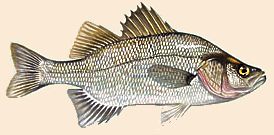|
White perch are an anadromous silver bass
in the fish family Percichthyidae.
These game panfish are the little cousin
of the striped bass, and share much of the
same Pennsylvania habitat, the tidal Delaware
and Schuylkill Rivers. White perch are found
also in Lake Erie and several manmade impoundments
throughout the southeastern portion of the
Pennsylvania commonwealth.

An angler's first white perch can cause confusion.
Juveniles are the size of sunfish, possess a few
faint horizontal stripes above the lateral line,
and resemble immature striped bass. White perch
are more rounded, though, and this pelagic shape
is retained in adults that range between one and
two pounds. Veterans of this size know the river,
as this species can reach a relatively old fish
age of ten to twelve years. Why this bass came to
be known as a perch can be traced to a mistaken
classification during the colonial era, when the
fish was first described as Perca americana.
A Fish With A Past
American shad were not the sole fish valued by our
colonial founders. White perch have the look and
solid feel of silver dollars, and were an equally
important commercial fish. So popular was the
white perch that when the oldest club of its
kind in the world, The Schuylkill Fishing
Company, formed near Philadelphia in 1732,
the white perch was adopted onto its flag of
state. The heraldry evolved into a single
white perch in profile, surrounded by a circle
of 13 stars and a red, white, and blue backdrop.
The Revolutionary War had by then begun, and
Generals George Washington and Marquis de
Lafayette dined on white perch in the club's
well-appointed fish house.
Fly-fishing For White Perch
Traditional fly rod techniques for stripers
work well for white perch. The key difference
to consider is hook size. A 2/0 Clouser Minnow
will never do. The same pattern, scaled down
to a panfish-friendly size 8 or 10, takes the
little cousin's preferred size of forage into
proper consideration. Other classic streamer
patterns, the Muddler Minnow and Gray Ghost,
can at times work wonders on white perch.
Trout enthusiasts may be delighted to know
another series of patterns, bead head caddis,
have proven to be successful flies for these
fish. The same casting techniques used for
trout need only be extended in range for the
larger, warmer water that white perch prefer.
Colors to match the hatch, in this case minnows,
seem to follow the rule "the lighter the better"
for white perch. The bright tan tone and flash
of the bead in motion must imitate a literal
"shiner" in the eyes of these aggressive,
sprinting fish.
White perch bite best during spring low tides
and are somewhat nocturnal, preferring to strike
most often during the two hours bordering both
sunrise and sunset. One exception is areas lit
by lights. Like schooling striped bass, white
perch congregate below the swarms of minnows
attracted to the lamps flanking roads and bridges.
On the evening I discovered the effectiveness of
caddis pupae imitations under artificial light,
I landed over a dozen fish from one large pool
in the Schuylkill River. The area was brightly
lit by nearby sodium streetlights. The
combination of nightlight and flashing bead
provided plentiful action -- and fun -- on
that memorable Friday evening in Philadelphia.
The most effective presentation mimics panic.
When feeding, white perch chase schools of
baitfish to the surface. Pods of the frantic
little fish skip the surface in all directions
in six to twelve inch hops. Target casts toward
these eruptions, which occur in otherwise calm,
or smoothly flowing, water. Start by stripping
the streamer across the surface in the same manic
manner. If that does not lead to a strike, a
sinking tip fly line or a small amount of
non-toxic split shot can drop the pattern down
the water column. Wherever the first fish strikes,
one can be sure another half dozen may follow.
This strategy works equally well in still water
environments. Anglers who fish for white perch
in lakes should concentrate their efforts after
dark around docks, piers, and jetties, not so
much for the structure as the light. These
surface areas can become roiled from the
nighttime drama of big fish, little fish.
Birds Are An Angler's Friend
An angler need not pursue these surface
disturbances, especially if the fish move
toward water that is unsafe to wade or boat.
When feeding frenzies move out of casting
range, or into dangerous water, seek other
indicators along the river. Fishing birds,
particularly cormorants and herons, are as
good as a human guide. Cormorants maneuver
into position above schools of fish and dive
down to dinner. Herons stalk the pools and
eddies where manic minnows have been chased.
White perch are among the prey of these
feathered predators. While I practice
catch-and-release as a rule, I am also
aware the white perch is an excellent
food fish for both bird and man. Spawning
fish in Pennsylvania's tidal rivers have
been fattened up in the fertile Delaware
Bay and Estuary. Savory preparations go as
far back as colonial times. A signature dish
of the Schuylkill Fishing Company -- white
perch fried in "the best butter of the
market" -- stands as a recipe that has
lasted as long as our nation. ~ ron

About ron:
ron P. swegman is the author of museum of
buildings: poems, and Philadelphia
On The Fly, forthcoming in 2005 from Frank
Amato Publications (Portland, OR). He lives, writes,
and casts lines in Philadelphia, PA.
|


